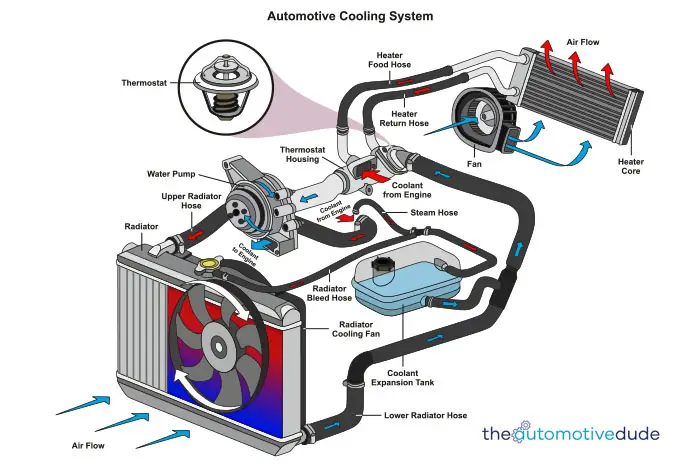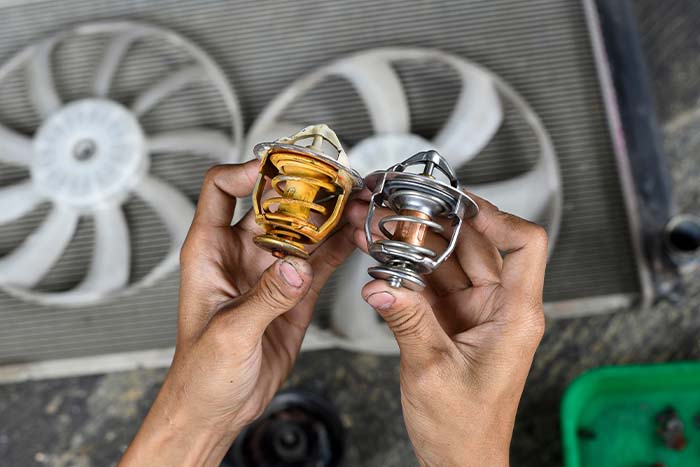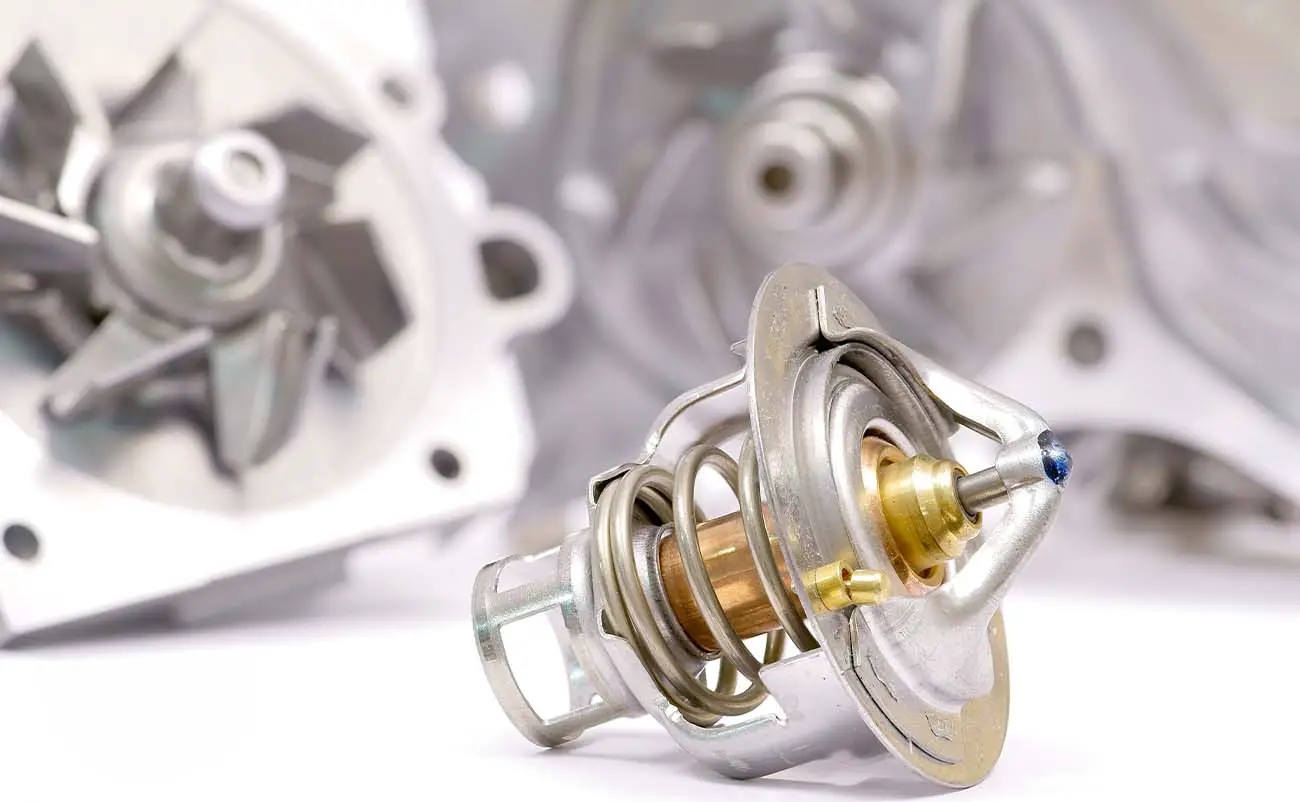A vehicle that is overheating can quickly cause catastrophic damage that can cost thousands of dollars to repair. Many engine components can cause an overheating engine, even something as small as the thermostat. Although small, the thermostat plays a vital role in your engine’s cooling system. We are going to look at what a car thermostat is and what warning signs you should look for when your thermostat goes bad.
Table of Contents
What Is A Car Thermostat?
A car thermostat is a cooling system component mounted in the engine block to regulate the flow of coolant to the radiator. The thermostat can be found in the thermostat housing, usually located at the top of your engine. Its job is to open and close based on your engine’s temperature to allow coolant to get to your radiator for adequate cooling. Car thermostats come in a variety of different temperature ratings to suit different motors.
A thermostat gasket is used to seal the thermostat in the housing to prevent coolant leaks. Thermostat gaskets are typically made from a heat-resistant rubber compound that can withstand the high temperatures of your cooling system.
Car thermostats are relatively cheap and easy to replace, but they can cause significant problems if stuck in open or closed positions. Since this component does not have a set maintenance schedule, replacing a thermostat when and if it malfunctions is suggested. However, many people choose to replace car thermostats during routine engine cooling system maintenance for additional peace of mind. When radiators, radiator hoses, heater cores, or coolants are replaced, changing the thermostat is a quick and easy way to prevent significant problems in the future.
How Your Car’s Thermostat Works

The thermostat in your car is a simple component as it simply opens or closes depending on the temperature of your coolant. If you have ever seen a car thermostat, you may argue that it does not look as simple as it operates. A car thermostat features a specific wax designed to expand once a particular temperature is reached. Once heated to the correct temperature, the wax expands, and your thermostat opens to allow coolant to flow.
When coolant travels through your engine, it picks up excess heat and travels to the radiator to extract this heat, keeping your engine at the desired operating temperature. When your engine is cold, you will want to keep this heated coolant in your engine longer to help reach the operating temperature quicker. This is where your thermostat comes into play.
If your coolant hasn’t reached your vehicle’s normal operating temperature, the thermostat will remain closed, preventing the coolant from traveling to the radiator. This allows the engine to heat up quickly for optimal performance. Once your coolant has reached optimal temperature, your thermostat will open up, allowing coolant to flow to the radiator and cool down before traveling back through your engine.
Signs Of A Bad Car Thermostat

If your car is overheating or having a hard time getting up to operating temperature, it’s likely there’s a problem with your car’s cooling system. If you are experiencing cooling issues and do not notice any visible problems, such as a leaking radiator or busted radiator hose, the problem could be your thermostat. Here are a few signs of a bad thermostat you can be on the lookout for to prevent catastrophic engine damage:
— Engine Overheating
A thermostat that is stuck in a closed position can cause your engine to overheat. This is due to the coolant not being able to pass through to the radiator to extract heat. Instead, the coolant is stuck behind the thermostat, absorbing all of the heat from the engine. If you start to notice your vehicle’s temperature gauge creeping into the red zone, you should pull over and shut off your engine immediately to prevent further damage.
— Engine Running Too Cold
A thermostat stuck in the open position can cause your car engine to run too cold. This is due to the engine coolant flowing through to the radiator too soon. Instead, the thermostat is not allowing the coolant to stay in the engine long enough to reach normal operating temperature. If you notice your vehicle’s temperature gauge is in the cold zone for an extended period of time, it’s a telltale sign that your engine is running too cold.
— Frequent Temperature Swings In Cooling System
A faulty thermostat can cause frequent temperature swings in your cooling system. If the wax has deteriorated, it may cause your thermostat to open and close at inconsistent temperatures while disrupting your engine’s coolant flow.
— Coolant Leaks
Coolant leaks caused by a thermostat usually come from a worn-out gasket or damaged thermostat housing. When the gasket wears out, or the mating surface of the thermostat housing is damaged, you may experience a coolant leak.
— Check Engine Light
A defective thermostat can cause a check engine light due to engine overheating. If the thermostat is full of corrosion and stuck shut, your engine can overheat, triggering a check engine light.
Car Thermostat Replacement Cost
Having your thermostat replaced is relatively cheap and can save your vehicle’s engine from extensive repairs down the road. On average, the cost for a thermostat replacement is between $127 and $216, including labor. The costs will vary depending on your car, the type of thermostat, and how difficult it is to access your vehicle’s current thermostat.
The Bottom Line
Now that we have discussed everything you need to know about car thermostats, you should feel more confident in identifying the warning signs of a malfunctioning thermostat. Keeping your thermostat in working order is essential to prevent hot coolant from destroying your head gaskets and ensuring optimum engine performance. If your vehicle’s temperature gauge is behaving abnormally, you should take your car to a certified technician specializing in your specific vehicle.
Frequently Asked Questions
What happens when a car thermostat goes bad?
When the thermostat in your car goes bad, you will notice that your vehicle is either overheating or not heating up at all. A faulty thermostat will not properly regulate your antifreeze flow, causing your engine to have cooling issues. The most common problem for a defective thermostat is corrosion from old antifreeze, causing the thermostat to become stuck in the closed position. This causes an overheating issue indicated by a check engine light or your temperature gauge with an abnormally high reading. If not addressed promptly, an overheating engine can lead to a blown head gasket. If you suspect your thermostat is misbehaving, you should have it serviced at your local auto repair center to keep your car running smoothly.
Can you run a car without a thermostat?
The thermostat is a vital component of your vehicle’s cooling system. Running your vehicle without a thermostat is not recommended as you will suffer from poor engine performance and terrible fuel economy. The only time you should operate a car without a thermostat is if it is stuck in a closed position and you need to drive your vehicle in an emergency.
How often should you change your car thermostat?
A car thermostat does not have a recommended service interval. If proper cooling system maintenance occurs, most thermostats will last for years, if not the vehicle’s lifetime. It is recommended only to change your thermostat when and if it malfunctions. Most car owners choose to replace the thermostat during routine cooling service, as it’s pretty cheap to replace a car thermostat anyway. Taking this preventative measure will ensure that corrosion does not reach your cooling system’s components.
What is the main cause of a car thermostat going bad?
The leading cause of a car thermostat going bad is corrosion from coolant not being changed regularly. By following your vehicle’s recommended maintenance schedule, you can ensure that your engine cooling system stays adequately serviced. By neglecting your cooling system, old coolant can become worn out and start to degrade your thermostat, water pump, and radiator, releasing small particles throughout your cooling system. A corroded thermostat can become stuck in a closed position, causing your engine to overheat.

